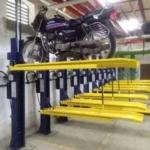Urban spaces in India are shrinking rapidly while the number of vehicles keeps growing. Two-wheelers dominate the roads in metro cities and even in smaller towns, but the biggest challenge riders face is finding proper parking. Traditional parking areas are unable to keep up with the demand, leading to congestion and inconvenience. This is where two wheeler stack parking systems are transforming the way people park in limited spaces.
Two wheeler stack parking is a modern solution designed to utilize vertical space rather than horizontal expansion. Instead of spreading parking across wide areas, these systems allow bikes and scooters to be stacked in multiple levels. This helps maximize capacity within the same footprint, making it ideal for commercial complexes, residential societies, shopping malls, and metro stations. By optimizing space, such systems save both time and resources for owners and operators.
The rising demand for two wheeler parking solutions is directly linked to India’s urbanization. Cities like Mumbai, Bengaluru, and Delhi face land scarcity, and setting aside large areas for parking is not feasible. Two wheeler stack parking offers a sustainable way forward by accommodating more vehicles in smaller plots. This also reduces on-road parking, which often causes traffic blockages. With improved organization, both riders and pedestrians experience a smoother flow in busy neighborhoods.
One of the key benefits of two wheeler stack parking is space optimization. A conventional open lot may hold 20 scooters, while a vertical stack system can accommodate double or even triple the number within the same space. This advantage is particularly crucial in commercial hubs, IT parks, and educational campuses where daily footfall is high. Property owners can make better use of land without investing in expensive expansions.
In addition to saving space, these systems also focus on security. With a structured design, two wheelers are neatly arranged, reducing the chances of damage, scratches, or theft. Many modern stack parking models integrate smart locking systems, CCTV surveillance, and access controls to ensure vehicles remain safe. For urban residents who worry about the safety of their scooters and bikes, this innovation provides much-needed peace of mind.
Convenience is another factor driving interest in two wheeler stack parking. Riders often spend several minutes searching for an empty spot, especially in congested areas like railway stations or markets. Stack systems streamline this process, allowing vehicles to be parked and retrieved quickly. Automated or semi-automated designs make the process smooth, reducing human intervention and minimizing errors. As cities push towards smart infrastructure, this solution aligns perfectly with the demand for efficiency.
From a cost perspective, two wheeler stack parking is highly economical compared to building large multi-level parking structures. Developers and property managers can invest in compact stack units that require minimal construction. The maintenance cost is also relatively low, making it a practical choice for societies, offices, and public spaces. In the long run, the savings on land acquisition and construction outweigh the installation expenses.
Environmental sustainability is another hidden advantage. On-street parking often leads to congestion, with vehicles idling and consuming more fuel. Organized two wheeler parking systems reduce unnecessary traffic movements, cutting down emissions. Additionally, compact parking layouts free up urban land that can be used for greenery or community spaces. By contributing to reduced congestion and better city planning, stack parking systems support eco-friendly development.
Technology plays a major role in enhancing two wheeler stack parking systems. Many advanced models come with user-friendly controls, automated lifts, and even app-based operations. Riders can reserve parking slots in advance, track availability, and save time. With smart cities becoming a focus area for government initiatives, integrating such intelligent parking systems is a step towards modernization. The blend of technology and infrastructure improves overall user experience and management efficiency.
Commercial establishments are among the biggest adopters of two wheeler stack parking. Shopping malls, office parks, and multiplexes rely on these systems to handle heavy traffic. With hundreds of daily visitors, efficient parking becomes a necessity rather than a luxury. By offering organized and spacious bike parking, businesses also enhance customer satisfaction. A positive parking experience often translates to better footfall and repeat visits, making it a valuable investment.
Residential complexes and housing societies are also turning to two wheeler stack parking as a long-term solution. Families often own more than one two-wheeler, and ground-level parking space becomes insufficient. By installing vertical stack systems, societies can provide equal allocation without disputes among residents. Moreover, it ensures a cleaner, more organized environment without vehicles cluttering driveways or pathways. This improves both aesthetics and functionality in shared living spaces.
Government and municipal authorities are also recognizing the importance of structured two wheeler parking solutions. Many cities are experimenting with automated parking systems near metro stations, bus stands, and government offices. This move not only helps reduce traffic chaos but also brings discipline to public spaces. With increasing adoption, two wheeler stack parking may soon become a standard requirement in urban planning guidelines across India.
The demand for smart parking systems is likely to rise as electric two-wheelers become more common. With e-bikes and scooters gaining popularity, the need for safe, organized, and secure parking is even higher. Two wheeler stack parking systems can be customized with charging facilities, ensuring EV users have convenient access to power points. This makes the system future-ready, aligning with the growing trend of sustainable mobility.
Two wheeler stack parking is more than just a convenience it is a necessity for modern cities. By addressing challenges of space, security, and efficiency, it provides a sustainable alternative to traditional parking layouts. Whether for residential complexes, commercial hubs, or public infrastructure, this solution ensures better management of urban mobility. As Indian cities continue to grow, stack parking systems will play a vital role in shaping smarter, safer, and more organized parking ecosystems.

